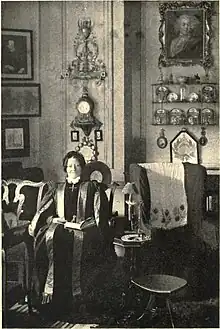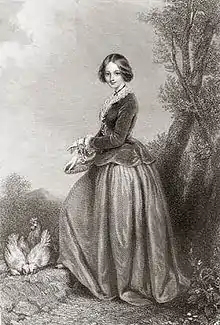Lady Dorothy Nevill
Lady Dorothy Fanny Nevill (née Walpole; 1 April 1826 in London – 24 March 1913 in London) was an English writer, hostess, horticulturist and plant collector. She was a founding member of the Conservative Primrose League, collected art, and cultivated a social network of talented friends including writers, artists, and politicians.
Lady Dorothy Nevill | |
|---|---|
 | |
| Born | 1 April 1826 |
| Died | 24 March 1913 |
| Occupation(s) | writer, hostess, horticulturist and plant collector |
Family and education
Nevill was one of five children of Horatio Walpole, 3rd Earl of Orford (1783–1858) and Mary Fawkener, daughter of William Augustus Fawkener, sometime envoy extraordinary at St Petersburg and close friend of Catherine II of Russia. Nevill was tutored by a governess in French, Greek, Italian and Latin.[1]
Scandal and marriage
In 1847, Nevill was embroiled in a scandal when she was linked with George Smythe, MP,[1] heir to a peerage. Smythe refused to marry her and this destroyed her reputation.

Later in 1847, Nevill married a cousin twenty years her senior. Her husband was Reginald Henry Nevill (d. 1878), a grandson of the 1st Earl of Abergavenny. Their marriage produced six children, only four of whom survived beyond childhood including Meresia Nevill.[1]
Nevill travelled extensively and cultivated a large circle of literary and artistic friends, with a sprinkling of politicians, including James McNeill Whistler, Richard Cobden, Joseph Chamberlain and Benjamin Disraeli, whom she greatly admired. She was however, never received by Queen Victoria.
Work as a horticulturist
In 1851 the Nevills acquired a large Sussex property, 'Dangstein' near Rogate. Dorothy Nevill turned the estate garden into a horticultural landmark. She employed 34 gardeners in her cultivation of orchids, nepenthes, and other tropical plants.[2]
Her exotic plants were housed in seventeen conservatories and were the subject of numerous articles in journals on horticulture. Through her plants, Nevill became friendly with both William and Joseph Hooker at Kew. She supplied Charles Darwin with rare plants for his researches. Dorothy was particularly known as an orchid grower, leading to a correspondence with Darwin that began in November 1861 when he wrote to ask for specimens to further his research towards his pamphlet on orchids.[3] Nevill was delighted to comply, and was duly acknowledged with a presentation copy.[4]
She kept exotic birds and mammals on the estate, farmed silkworms and maintained a museum of her collections. After her husband's death, he left all his money to their surviving children to curtail her expenditures. Nevill moved to 'Stillyans' near Heathfield in Sussex, which she rented from one of her botanist friends, Robert Hogg.[5]
Collector
In the 1860s Lady Dorothy had established a large ceramic collection including Sèvres porcelain objects. She knew Napoleon III, Empress Eugénie, Princess Mathilde and Prince Demidoff personally and after the Franco-Prussian War she regularly visited Paris for her collections.[6]
Salon hostess

Nevill was a noted conversationalist - "The real art of conversation is not only to say the right thing at the right place, but to leave unsaid the wrong thing at the tempting moment." - and leading society hostess. Her salons attracted celebrities and politicians. She served on the first committee of the Primrose League.
Memoirist
Nevill wrote a number of volumes of memoirs:[7]
- Reminiscences (1906)
- Leaves from the Notebooks of Lady Dorothy Nevill (1907)[8]
- Under Five Reigns (1910)
- My Own Times (1912).
- Mannington and the Walpoles, Earls of Orford (1894) [9]
Death
Lady Dorothy died at her home at 45 Charles Street on 24 March 1913, where a memorial plaque was unveiled on 8 September 1998.[10]
Children and legacy
Her son, Ralph Nevill, wrote Life and Letters of Lady Dorothy Nevill (1919). Her daughter, Meresia Nevill was also a leading worker for the Primrose League. She served for many years as treasurer of the Ladies' Grand Council and died in London on 26 October 1918.[11]
References
- Matthew, H. C. G.; Harrison, B., eds. (23 September 2004). "Lady Dorothy Nevill". Oxford Dictionary of National Biography (online ed.). Oxford: Oxford University Press. doi:10.1093/ref:odnb/37805. Retrieved 27 June 2023. (Subscription or UK public library membership required.)
- Desmond, Ray (11 September 2002). "Nevill, Lady Dorothy Fanny née Walpole". Dictionary of British and Irish Botantists and Horticulturalists Including plant collectors, flower painters and garden designers. CRC Press. p. 2235. ISBN 9781466573871.
- "Letter from Charles Darwin to Dorothy Nevill, 12 November 1861". Darwin Correspondence Project.
- "Letter from Charles Darwin to Dorothy Nevill, 19 November 1861". Darwin Correspondence Project.
- Newsletter, St. Mary's School, Term 3
- McCaffrey-Howarth, Caroline (2021). "'Life was a spectacle for her': Lady Dorothy Nevill as Art Collector, Political Hostess, and Cultural Philanthropist". 19: Interdisciplinary Studies in the Long Nineteenth Century. 2020 (31). doi:10.16995/ntn.3344. ISSN 1755-1560.
- Marilyn Ogilvie and Joy Harvey, eds., The Biographical Dictionary of Women in Science
- "Lady Dorothy Nevill". Kalgoorlie Miner (WA : 1895 - 1950). 26 March 1913. p. 5. Retrieved 4 June 2018.
- The Correspondence of James McNeill Whistler Archived 2008-02-11 at the Wayback Machine
- City of Westminster green plaques "Westminster City Council - Green Plaques Scheme". Archived from the original on 16 July 2012. Retrieved 7 July 2011.
- Matthew, H. C. G.; Harrison, B., eds. (23 September 2004). "Meresia Dorothy Augusta Nevill". Oxford Dictionary of National Biography (online ed.). Oxford: Oxford University Press. doi:10.1093/ref:odnb/56260. Retrieved 27 June 2023. (Subscription or UK public library membership required.)
Trotter, W.R. (1988). "The Glasshouses at Dangstein and Their Contents". Garden History. 16 (1): 71–89. doi:10.2307/1586906. JSTOR 1586906.
External links
| Library resources about Lady Dorothy Nevill |
| By Lady Dorothy Nevill |
|---|